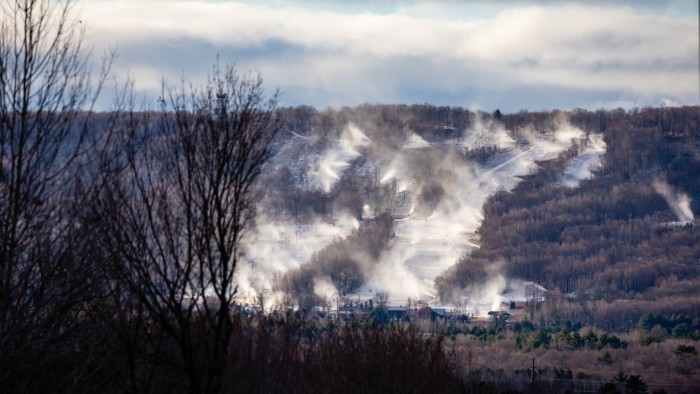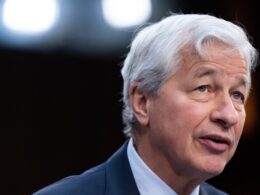Unlock the Editor’s Digest for free
Roula Khalaf, Editor of the FT, selects her favourite stories in this weekly newsletter.
The writer is a contributing columnist, based in Chicago
Winter is getting shorter in the US Midwest, threatening the beloved cold-weather culture of skiing, ice fishing, dog sledding and ice roads. But now Midwesterners are using technology to fight back. Practices such as more efficient snow-making and even “snow farming” are becoming more common in our bid to extend winter fun.
One Michigan resort is promising that by farming snow — scouting it out, scooping it up and stacking it to a self-insulating depth of 20 feet on one slope — skiing can continue until summer. “You’ll be able to ski in the morning and play 18 holes of golf in the afternoon on the same property,” Jason Perl, general manager of Michigan’s Boyne Mountain Resort told me. Temperatures in the area have average highs over 21C in June: that wasn’t ski weather when I was at that resort in my childhood and broke my ankle.
“We can’t just rely on Mother Nature any more. Because of climate change we’ve had to be more versatile,” says Perl. “We’ve had to invest in better snow-making — these days, it doesn’t even need to be cold outside to make snow.”
Perl says Boyne, a low-elevation resort with only a 500ft ski hill, will have to make most of its snow first, in order to farm it. But at Monarch Mountain in Colorado, with a base area at more than 10,000ft, snow is never made — only farmed. Malcolm Wilber, assistant director of operations there, tells me this is an intensive business, from cutting grass to minimise the amount of snow needed to cover a slope, to using pop-up fences to trap snow for farming.
Climate change has put pressure on low-elevation resorts to find new solutions, winter sports experts say. According to the US Environmental Protection Agency’s “climate change indicators”, the US snow cover season shortened by nearly two weeks between 1972 and 2013, with the last day of snow shifting earlier by 19 days.
That has hit the US ski industry hard. One study found it lost $5bn between 2000 and 2019 due to climate change. Lack of snow has hit snowmobile demand too: two of the biggest snowmobile producers are halting production, says Jaime Katz of Morningstar.
But the irony is that climate change is at the same time increasing snowfall in areas near the Great Lakes. These lakes, which represent about a fifth of the freshwater on Earth, are among the fastest-warming ones in the world, according to a US government climate study. Annual maximum Great Lakes ice coverage decreased by about 5 per cent per decade between 1973 and 2023. And when they don’t freeze, more water can evaporate and fall on nearby land as “lake effect” snow. So less ice can lead to more snow — which could be good for ski resorts like Boyne.
But that won’t help sports such as ice fishing, dog sledding or my own favourite, driving across frozen lakes in cars. All these have seen festivals cancelled due to lack of snow or ice — especially last year, the warmest on record for Michigan and Wisconsin.
“It’s going to be a bigger and bigger problem. Over the next few decades you’re just not going to be able to do those sports very much,” Donald Wuebbles, emeritus professor of atmospheric science at the University of Illinois, told me. He adds that snow-making consumes fossil fuels and uses a lot of water. Americans might need to go to Canada for winter fun in future, climate experts said — assuming the Canadians are still willing to have them.
Shelby Brunner of the non-profit Great Lakes Observing System says less ice will have a “cultural impact” on the Midwest. “I remember my dad and grandpa ice fishing in the 1990s [in Michigan] but they don’t do that any more because the ice isn’t reliable enough.” And a dramatically shortened season “is not worth the effort”.
So will my generation be the last to grow up crouching in a shanty on a frozen lake, ice fishing with a grandparent? Will we be the last to safely drive across a Midwest lake in winter, just to get to the other side? Maybe so — but as Brunner notes, that just “makes room for new pursuits going forward”. Skiing and golfing on the same day, perhaps.
Source link









